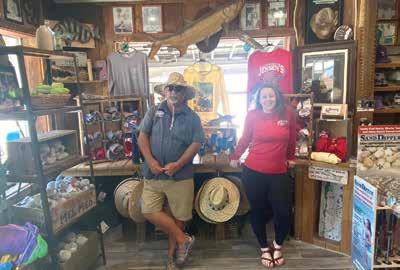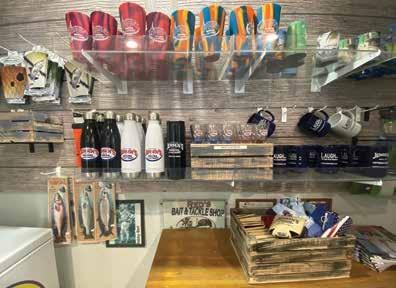
2 minute read
Surf Expo Special Beach and Resort Report
Where There Is No Shortage (From page 59)
shirt sales go down for a bit because customers couldn’t see any of the T-shirts when they walked in, expressed Lujan. During that time, customers had to ask where they were, he explained. Once they moved them further in front of the store and placed them on spinning painted racks, decorated them with driftwood and made the display enticing, they were flying off the shelves again.
“We’ve even had people get off the boats before and tell us we’re just here for a Jensen T-shirt,” Lujan said.
For the past few years at BI Tees on Block Island, customers have been loving the pigment or garment dyed look, said Co-Owner John Cullen . In fact, they stock T-shirts from several different vendors producing that type of shirt.



Because they’re both on an island and the beach, people gravitate to coastal-type designs. The shape of Block Island is unique, so T-shirts using that shape as part of the design are popular. Other popular coastal designs include sharks, pirates or surfboards. Designs that include dogs have been popular the past few years, mentioned Cullen. Often, these designs include dogs depicted alongside an aspect of the coast. For instance, designs sold at the store have included dogs on the beach or a dog with a fish in its mouth.
When it comes to T-shirt display, it’s important for customers to be able to see the design. The part of the T-shirt facing the customer should have the largest part of the design on it. “It’s important that the customer is able to see all of the design,” said Lujan. “This catches the customer’s eye – the designs and col-
Continued on page 62
Where There Is No Shortage (From page 60)
ors help to lure them in.” Putting them on a round rack where you can’t really see the designs isn’t helpful, said Cullen. “Seeing the T-shirt is what helps drive sales,” he said.
According to Cullen, keeping a good Tshirt display at their 500-square-foot store takes constant maintenance. At BI, employees are trained to organize the display after customers have rifled through the T-shirts.


Cullen finds that putting size rings on the hangers helps to make T-shirts easy to find for both customers
Continued on page 64
What Are Your Most Popular Sunglass Styles and Why?
Being in a vacationer’s area, high profile sunglasses like RCI, Ray-Ban’s or Costa’s that run in the $200 to $300 range are a hard sell. Instead, Jensen’s Marina and Cottages Operations Manager Cody Lujan said customers want something that’s functional, and polarized. They carry entry level sunglasses from a local dealer. At a $20 price point, they carry every size and dimension you can imagine, Lujan said. Their rotating display carries about 100 sunglasses. “They’re priced right, hold up and they look cool,” Lujan said.
It's more difficult to find something that’s somewhere between cheap and luxurious, but for customers looking for something more special, they carry Suncloud sunglasses, a subsidiary of Smith. They’re polarized, come in a velvet bag, “won’t snap in two” and sell for $44.95. At Jensen’s, they sell these sunglasses at a lower price than the retailer recommends because they value the high turnover the lower price point brings.
At BI Tees, their sunglasses go from $18 to $30. They used to stock more expensive sunglasses, but those took too long to sell according to Co-Owner John Cullen.
Cullen also said aviators are still popular at their store. They’re purchased by young and old. Younger customers also gravitate towards sunglasses in bright fun colors. This also helps draw attention to the display.
It’s very much a self-serve type of display, said Cullen. “At that price point, you don’t really need to educate customers on filter and lens.” And once a pair has been purchased, they replace it with another as soon as they can to keep the display looking full. ❖






